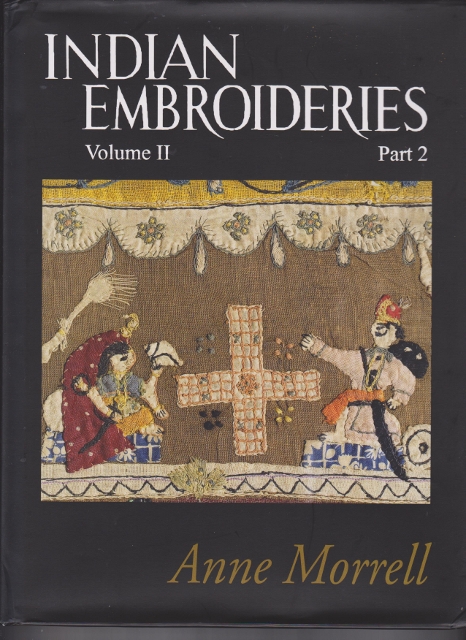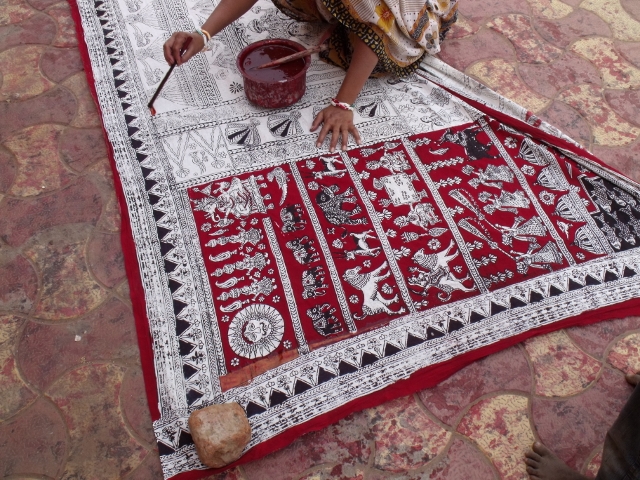Indian Embroideries 2 is the new Calico Museum publication by Anne Morrell. Gira Sarabhai tells us that at the start that the book is to be seen as a supplement to the book of the same name, part 1, published in 1973, and written by John Irwin and Margaret Hall. Having contributed some images for the book, I was sent a complimentary copy a few weeks ago. I was delighted to receive the familiar Indian stitched calico package, and the book inside was definitely worth the wait. The book cover closely resembles the original, using a similar font for the title, a black background and an image of an appliqued pictorial design depicting two figures playing the popular Indian game chopad, which is the subject of one of the book’s chapters. At the beginning of the book there is an overview of the Calico Museum in Ahmedabad and its history, an overview of the Indian Embroidery Techniques Gallery which Morrell set up, and an introduction to Indian Embroidery.

The present volume features newer objects added to the Calico’s collection during the period since the first volume was published, and informed by new facts and classification. The book is rich in imagery throughout that shows whole pieces and close up detail. One thing Morrell works hard to achieve is bringing to life the story of a particular embroidery style, its process and context. The bulk of the book covers products rather than stitches, each grouped under its geographical region. These include Saurashtra and Kutch, Punjab and Bihar. Details of the stitches are included in the technical notes in the back, and also at the back is Migration of Stitches originally produced by Morrell as gallery notes for the Technical Embroidery Gallery at the Calico Museum.

Double page spreads are well composed to display the context of regional styles. For example, the rich ari embroidery from Kutch (which I have written about in a previous post) is shown though a traditional ghaggra skirt from the late 19th to early 20th Century, Gujarat along with ari workers at practice, the ari tool and fragments of an ari embroidered blouse.

The chapter on Bolster and Cushion Covers in the Kutch section shows images of cotton beating in a small domestic courtyard in Ahmedabad. There are also images of old Mughal paintings which feature bolsters in use. Another embroidered product featuring in Mughal paintings are games, particularly chopad, a classic Indian game from which many games all over the world have derived. Chopad is the subject of another chapter, and is shown in various settings and in various forms including a small chalk board, an oversized concrete chopad at Fatepur Sikri and a richly embroidered chopad which includes pockets for the counters and game accessories. There is also a wonderful image of chopad being played.

It is interesting to see products in use, for example the richly embroidered folded bags hung from the snake charmer’s pole; inspiration for embroidered motifs such as the lily; and the ways of applying a design for the embroidery to follow, such as the metal-wood blocks made in Ahmedabad. The book is also accompanied by a DVD which comprehensively documents the various processes involved in the embroidery styles covered in the book. Videos are accompanied by text which explains each stage of the process.
Some of the hand processes covered in the book are fast disappearing so the book serves as an important resource and one which will be useful for designers, craftspeople, researchers, students and museum workers alike.
You can order the book from the Sarabhai Foundation / Calico Museum website: http://sarabhaifoundation.com/



2 Comments
Prashant Prajapati
Namaskar Ruth,
I have been looking at your blog and it is quite interesting. Being a Gujarati, I even enjoyed it more, specially because I just bought some Mata ni Pachhedi from Jayantibhai Chitara. Calico Museum and Gira Sarabhai have contributed enormously for the documentaion of Ancient Indian textiles. Any book that comes out of their stable is always a great read and informative for students, researchers, enthusiasts, great coffee table books for public places…
The reason I am writing this to you is because I only see designs (dyed, printed and painted) on cloth/textile (from Gujarat) in the blog. Gujarat and for that matter India also has a very rich tradition of textile weaving…which I failed to locate on the blog. Below are a range of Hand woven textiles in Gujarat. Do you have any writings on the same?
Hand-Woven textiles
Bhujodi weaving
Mashru
Single Ikat textiles
Kharad
Handwoven Textiles of Saurasthra
Patola (Both single Ikat and double Ikat)
Dhabla
Tangalia
Sujani
Durries and carpets
Brocade weaving
Gharchola/Panetar
Enthusiastically awaiting your response.
Prashant.
Namaskar Prashant,
Thanks for your comment. I’m pleased you’ve enjoyed reading my blog.
Its funny that you should mention the lack of posts on constructed textiles and the other textile traditions you mention, as I am planning on writing on many of these, so do keep your eye out. Forthcoming posts will be Mashru, bhuhodi weaving and patola weaving. The others I know less about but will certainly research them. Also following my trip to India later this year, I should have lots of new material to work on.
Best,
Ruth